All Library locations will be closed Monday, January 19 for Martin Luther King, Jr. Birthday.
“What’s your KC Q” is a joint project of the Kansas City Public Library and The Kansas City Star. Readers submit questions, the public votes on which questions to answer, and our team of librarians and reporters dig deep to uncover the answers.
Have a question you want to ask? Submit it now »
By Dan Kelly
The Kansas City area is clearly the cradle of bandit brothers, having produced perhaps the nation’s two most notorious sets of outlaw siblings, Frank and Jesse James and the Youngers.
But let’s not forget the Daltons.
The Dalton boys are more associated with southern Kansas and what is now Oklahoma, which they terrorized in the late 19th century, some 20 years after the Jameses and Youngers were in their prime. But the story of the Dalton brothers, who were cousins of the Youngers, began in the Kansas City area, where they all were born.
In a way, the story ended here as well.
The Daltons were on the mind of reader Bill Flamank (if the name sounds familiar, Flamank played basketball at Raytown South High School, leading the Cardinals to a state title in 1970, and at the University of Missouri). He asked “What’s Your KCQ?,” The Star’s ongoing series with the Kansas City Public Library that answers readers’ queries about our region:
What is the history of the Dalton Gang and ties to the Coffeyville bank robberies and even the Youngers?
Those familiar with the Dalton Gang might argue that its demise took place in a bloody 1892 shootout in the streets of Coffeyville, Kansas, where three Daltons and two other outlaws attempted to rob two banks simultaneously. Eight men died — four townspeople, two Dalton brothers (Grat and Bob) and the two other outlaws (Bill Powers and Dick Broadwell).
But one Dalton boy — Emmett — survived that calamity.
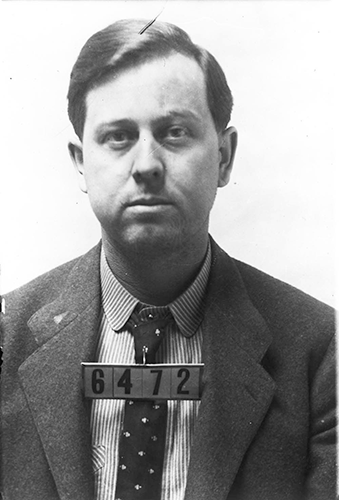
prison and then starred in a few movies. | Kansas Historical Society
And he took what could be considered the Daltons’ final bow on the pages of The Kansas City Star nearly 40 years later.
On May 10, 1931, The Star ran a two-page spread describing Emmett Dalton’s return to Coffeyville, where he relived the Oct. 5, 1892, shootout and was celebrated by townsfolk. The town, which is two miles north of the Oklahoma border and about 60 miles due west of Joplin, was then, and still is, known far and wide because of the Daltons’ last stand, drawing tourists from around the globe to its Dalton Museum and other attractions.
Multiple books and movies (including one in which Emmett played himself) had told the Daltons’ story — or at least largely fictionalized versions of it. But The Star’s 1931 story was different.
Written by a man who had just won the Pulitzer Prize — the first in The Star’s history — it became a source for the many serious books and articles about the Daltons that were to follow.
Coming just six years before Emmett Dalton died at the age of 66 in Hollywood, the article appeared six days after it was announced that The Star’s A.B. MacDonald had won the Pulitzer for his story uncovering the guilty party in a murder in Amarillo, Texas.
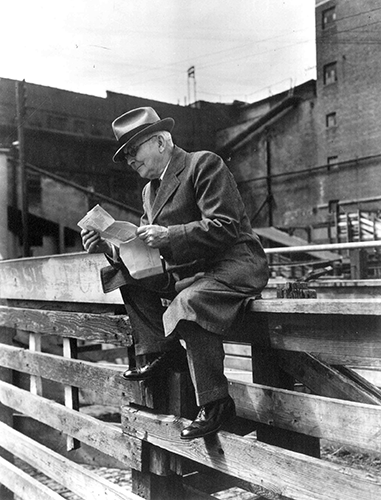
wrote a 1931 story on Emmett Dalton’s return to Coffeyville. | File Photo
Even before the Pulitzer, which he won at the age of 69, MacDonald had established his reputation as a top-notch journalist. He had an amazing background as well, having been born in Canada, then worked as a lawyer, traveling salesman, real estate salesman and circus promoter before landing in the newspaper business in the late 1800s.
The Dalton/Coffeyville story was one of the dozens of major pieces that MacDonald wrote for The Star, where he worked until his death in 1942 at the age of 79.
Writing in the first person, MacDonald described the scene as he and Emmett walked the streets of Coffeyville, revisiting the specific locations where events on that fateful day in 1892 took place and encountering still-living witnesses.
As they started their stroll through town, Dalton and MacDonald met up with John B. Tackett, who not only had watched the 1892 shootout but had taken photographs of the dead men. The photos made him a rich man and continue to be published worldwide today.

and Dick Broadwell, were photographed by John B. Tackett after being shot to death
in Coffeyville, Kansas. | File Photo
MacDonald summarized Tackett’s experience in one mesmerizing sentence:
“Tackett, then a boy, was on the Plaza in Coffeyville that October morning thirty-nine years ago and saw five Dalton bandits come out of an alley, each with a Winchester rifle balanced in his right hand, saw them go at a dog trot across the street, heard the quick scuffling of their cowboy heels upon the brick pavement as they ran, saw them divide into two groups and enter the two banks, saw all the battle that followed, in which eight men were killed and four wounded, peeked from behind a corner and saw the five bandits making their last stand in “Death Alley,” saw all killed but Emmett Dalton and watched him ride into the alley with the $23,000 of loot in a sack and saw him throw the sack across his saddle and then mount.”
The bulk of the rest of the article related further details of that day as described by Emmett Dalton, including how he, Bob and Grat had decided to rob two banks at once in broad daylight because it had never been done before, that it was supposed to be their last big haul before quitting banditry and heading to South America and that they expected to take the town by surprise, how they expected to get in and out of First National Bank and the Condon Bank in two or three minutes but encountered two “mischances,” discovering that street work would prevent them from hitching their horses on Eighth Street and thus were forced to park their mounts in what became known as “Death Alley,” and ultimately being outsmarted by a Condon Bank cashier.

The Dalton Gang attempted to rob the Condon and the First National Bank at the same time.
The First National Bank was destroyed by fire a few years after the raid. | File Photo
Dalton said:
“Charley Ball, the cashier, was a man of nerve and quick wit, and when Grat ordered him to open the money safe Bell answered that it had a time lock, which would not open for ten minutes.
“The truth was, there was no time lock. The safe door could have been swung open easily and there was $18,000 in there, ready to hand. Had Grat tried the door of that safe he would have got that money and been out of the bank in a minute, and we would have got away before the town armed against us.
“That ruse of Ball about the time lock was the one outstanding act of the citizenry of Coffeyville that day. It saved his bank $18,000, but it also was the cause of eight deaths within the next few minutes.”
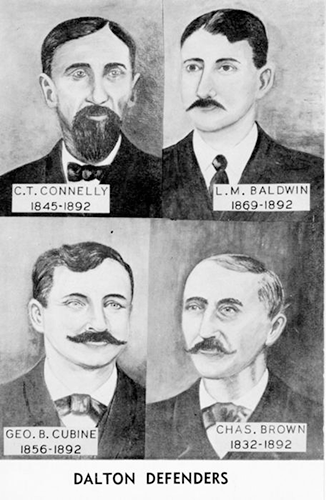
the Dalton Defenders — C.T. Connelly, L.M. Baldwin,
Geo. B. Cubine and Chas. Brown — who were killed during the Oct. 5, 1892,
shootout in Coffeyville. | Kansas City Public Library
Dalton went into great detail describing those few minutes of mayhem, highlighted by his stroll down Death Alley.
“This whole alley was thick with a haze of smoke from our rifles and from the guns of citizens who were shooting at us from the sheds and board fences along the alley. Bullets whined and kicked up clouds of dust. … The rifles sounded like the popping of corn in a skillet.”
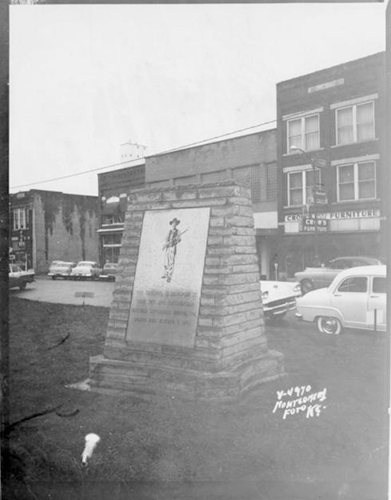
“This Memorial is dedicated to those men who successfully defended
Coffeyville during the Dalton raid, October 5, 1892.” |
Kansas City Public Library
Somewhere along the way, Emmett got sidetracked by memories of his youth in Missouri.
“Poor mother, we gave her plenty of trouble. She was a Younger, sister of Henry Younger, father of Cole, Bob and Jim Younger, the outlaws. They were my cousins. I was born in Belton, just a little way south of Kansas City, right in the heart of the ‘dark and bloody ground’ of the border wars.
“In my boyhood I heard all about those kinsmen of mine, with Jesse and Frank James, renegade actions of distinguished families, and their exploits fired my young imagination. They were fighters, and I learned early that you had to be a fighter to have men talk about you in the grocery store.”
Emmett related how his father bought a bay mare that had belonged to Jesse James, and the neighborhood boys took turns riding it. He also told a story about two men posing as stock buyers visiting the Daltons’ house.
“Father did not tell us nor mother did not tell us who they were until long after the Youngers were captured in the Northfield Bank raid in Minnesota, and then father told us: ‘Those two men you saw that day were Jesse James and your cousin, Cole Younger.’
“Mother was always bitter against her nephews, the Younger boys, because of their raiding and robbing, and she forbade us to talk about them. Mother was straightlaced and downhard on outlaws. I cannot say, now, what influence that environment of my youth and our close kinship with the Youngers had to do with our becoming bandits, but undoubtedly it had some.”
The Daltons’ mother had been born a Younger, but their father likely had a greater impact on their eventual life of crime. Lewis Dalton, born in Kentucky, came to Missouri in the late 1840s and married Adeline Younger of Independence in 1851 when she was 15 and he was 25. They produced 15 children, including 10 boys.
Lewis Dalton ran a saloon in Westport before moving the family to Cass County, where Adeline’s parents gave them land. The family soon moved on, bouncing around in Missouri, Kansas and what is now Oklahoma before ultimately settling in Coffeyville, which the Dalton boys considered their hometown.
Before turning to banditry, Grat and Bob Dalton tried their hand at law enforcement.
Their older broker Frank had become a deputy U.S. marshal riding out of Fort Smith, Arkansas, for Judge Isaac Parker, the hanging judge. He hired Grat as his assistant, and when Frank was killed in 1887 trying to capture a band of whiskey runners, Grat took his brother’s job and hired brother Bob.
Grat and Bob didn’t last long as good guys. By 1890, they were robbing trains and banks with brothers Bill and Emmett and others. Their reign of terror lasted less than two years before the failed Coffeyville raid.
Bill, who wasn’t with the gang at Coffeyville, went on to create havoc as part of the infamous Doolin-Dalton Gang for several years before being tracked down and killed in August 1896 by U.S. Deputy Marshal Heck Thomas near Lawson, Oklahoma.
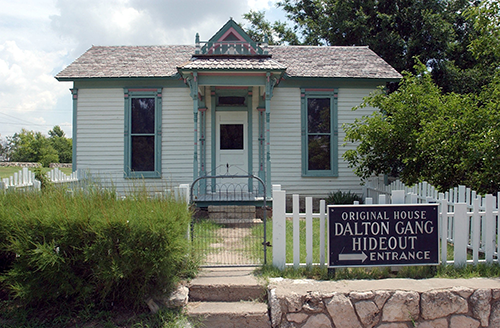
Thus, by 1931, Emmett was the lone remaining Dalton boy (at least among the ones who had turned to crime). After recovering from the wounds he suffered in Death Alley, he served 14½ years in prison before being pardoned by Kansas Gov. E.W. Hoch in 1907. He married his childhood sweetheart, Julia Johnson, and they moved to Tulsa. A decade later they headed to Hollywood, where Emmett found limited success in the movie business.
During his 1931 return to Coffeyville, nostalgia was very much the order of the day. It included a trip to Elmwood cemetery, where Emmett stopped with MacDonald at the graves of brothers Frank, Grat and Bob as well as of Bill Powers.
“I challenge the world to produce the history of an outlaw who ever got anything out of it except that,” and he pointed to the row of outlaw graves, “or else to be huddled in a prison cell. … The biggest fool on earth is the one who thinks that he can beat the law, that crime can be made to pay. It never paid and never will, and that’s the one lesson of the Coffeyville raid.”
Submit a Question
Do you want to ask a question for a future voting round? Kansas City Star reporters and Kansas City Public Library researchers will investigate the question and explain how we got the answer. Enter it below to get started.
